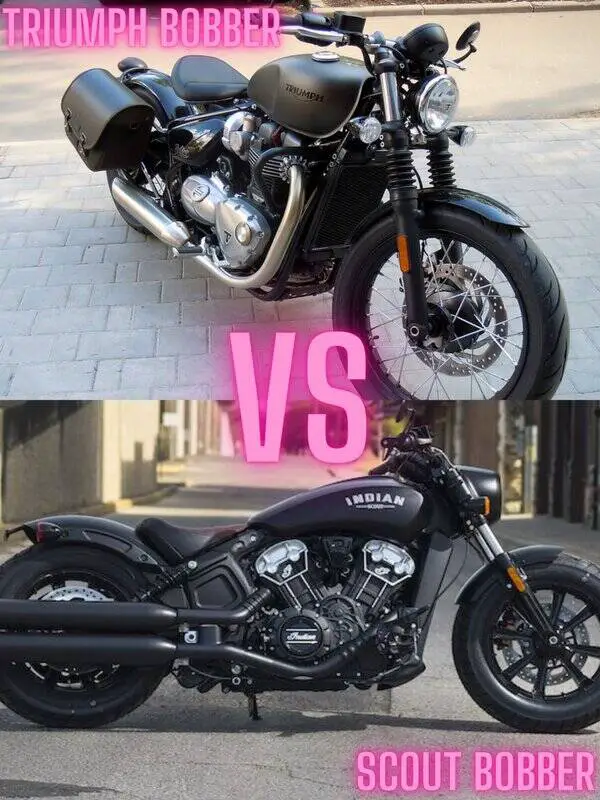These are cruisier bikes that have been stripped down to reduce weight. But that’s where the similarities end. The Scout has a more powerful liquid-cooled V-twin engine that enables it to reach top speeds of about 128 mph. In contrast to that, the Triumph Bobber follows a more streamlined design, with a top speed of a mere 93 mph.
So, what truly sets these bikes apart?
Here’s our final comparison between the Scout Bobber vs. Triumph Bobber.
Industry History:
Indian Motorcycle:
Indian Motorcycle is an American manufacturer of motorcycles based in Minnesota. It was originally founded as the Hendee Manufacturing Company. Today, the Indian Motorcycle has grown to be one of the most popular bike manufacturers. The company is famous for its Scout and Chief models, product lines that are decades old.
Triumph Bobber:
Triumph Motorcycles Ltd is one of the UK’s largest motorcycle brands, originating as the Triumph Engineering company. When that company went into receivership, Triumph took over. It started mass-producing motorcycles. Initially, the production was halted due to the condition of t6he manufacturing plant. But Triumph triumphed. And it now produces over 63,000 bikes a year.
Scout Bobber Vs. Triumph Bobber – An Overview:
Scout Bobber:
Engineered as a cruising bike, the Indian Scout is a bobbed-down version of the standard Scout. It’s built upon the same chassis and V-twin water-cooled engine. What’s changed, however, aside from the bobbed design, is the riding experience.
The Scout Bobber is a 100-horsepower motorcycle that thrives on asphalt and pavement. It’s fitted with a V-twin engine that delivers smooth power to the drive chain. And with its ergonomic seating and twin-shock forks, it stays on the road for longer.
Triumph Bobber:
Everything about the Triumph is unique, from the engine to the suspension and even the aesthetics. The Triumph Bonneville Bobber stands out with its ultra-slim tank and small parallel-twin engine. The level of aesthetic and design is one you normally wouldn’t see on a Bobber.
And unlike other on-road bikes, the Triumph features a Showak fork at the front. It’s able to withstand higher levels of compression and can take on more rugged urban planes.
Comparison Chart:
| Features | Scout Bobber | Triumph Bobber |
| Fuel and Vehicle Type | Gasoline Bobber | Gasoline Bobber |
| Fuel Tank Capacity | 3.3 gallons | 2.4 gallons |
| Displacement | 1133 cc | 1200 cc |
| Max Power | 100 hp | 76 hp |
| Max Torque | 72 lb.ft | 78 lb.ft |
| RPM @ Max Torque | 3300 RPM | 4000 RPM |
| Seating Capacity | 1 | 1 |
| Weight | 534 lb. | 553 lb. |
| Gear Transmission | 6-speed | 6-speed |
| Rear & Front Suspension | Front: Non-adjustable 41 mm fork Rear: Spring-preload adjustable shocks | Front: Non-adjustable Showak cartridge fork Rear: Linkage-assisted non-adjustable mono-shock |
| Rear & Front Wheel Size | Front: 130/90 x 16 Rear: 150/80 x 16 | Front: 130/90 x 16 Rear: 150/80 x 16 |
| Seat Type | Single Seat | Single Seat |
Engine:
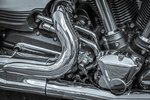
When it comes to power and torque, both the Scout Bobber vs. Triumph Bobber like to go all out. The Indian Scout Bobber uses a water-cooled V-twin engine that delivers up to 100 horsepower and 72 pound-feet of torque. It’s appropriately sized for a Bobber, with a displacement of 1,133 cc.
As compared to that, the Triumph Bobber features a parallel-twin engine. It’s a much-needed departure from the traditional Bobber design. And it’s smaller than its V-twin counterparts too. It has a peak torque of 78 pound-feet and a peak power output of 76 horsepower in terms of performance.
Comparatively, both the engines are quite similar in terms of work and power. Even the torques are similar. However, the Indian Bobber has a displacement of 1,133 cc while the Triumph has 1,200 cc. The difference is subtle, but it can change the game completely. And the Scout delivers more power to the drive chain than the Triumph
One more thing is, since the Triumph uses a parallel-twin setup, it’s a lot smaller. But putting that aside, due to its higher power and RPM, the Scout wins this round.
Weight:
How important is weight on a motorcycle? More than you think. Effective weight management makes all the difference between a bike that maxes its fuel economy and one that wastes it. And considering both the Scout Bobber vs. Triumph Bobber are Bobbers, it makes sense that they cut down on excess weight.
The Indian Scout Bobber has a dry weight of about 534 pounds. And the Triumph Bobber has a dry weight of 553 pounds. As you can see, the Triumph is almost 20 pounds heavier. This means it will consume slightly more fuel, resulting in lower gas mileage.
Fortunately, the difference is only subtle. And neither Bobbers are overweight. So, handling and controlling them is still a breeze. The only difference is the extra weight of 20 pounds that the Triumph packs slightly bring down fuel economy.
By that standard, the Scout Bobber is the better choice for its lower weight.
Suspension:
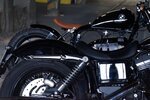
Suspension is a crucial buying factor that, unfortunately, most people don’t know much about. When it comes to suspension and riding comfort, the Triumph leads the way.
And it’s not hard to guess why. Its front suspension uses Showa cartridge forks, which make the Triumph a beast on the road. Off the road, however, it’s not all that well-adapted. But given it’s a cruiser, off-roading isn’t a significant concern.
As for the rear suspension, it’s a mono-shock RSU with linkage, a type of fork that conquers on the road. Much like the front fork, it’s not good for off-roading.
When compared with that, you can see why the Indian Scout Bobber falls short. It uses a standard telescopic fork for its front suspension, and a twin shock set up for its rear suspension. You may argue that the rear shock is much better, and you’d be right. But it’s the front shock that we have an issue with. Plus, the rear travel of the Scout Bobber is hardly two inches.
For those reasons, the Triumph Bobber takes the cake.
Ergonomics:
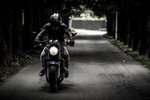
Many riders ditch certain bikes, not for their low performance, but because they’re not comfortable. When you’re riding for hours sitting on a hard bike seat, the journey is less than exciting if it is uncomfortable.
The bikes have been taken out for a test run for around 30 minutes, which is where the Scout Bobber shined. Now, naturally, the Bobber style of motorcycles snatches away a lot of the comfort you would usually get. But the Scout tries its best, which deserves complementary points.
The seat on the Scout is a lot more comfortable, providing adequate support to your back and rear. The bike’s design allows its seat to sit relatively low, which may feel more comfortable for other people.
However, on the Triumph, the seat is quite hard, and you’ll find your bones digging into it. One thing that does make the ride a slightly better option is the seat height. It’s higher than on the Scout and gives you a better view of your surroundings. The seat is also adjustable, though I’ve yet to find a position more comfortable for me.
All in all, both the bikes stand out as ergonomic decisions. But since you can easily ride longer on the Scout, it’s the clear winner here.
Electronics:
While not a necessity, electronic controls and components are always good to have on your motorcycle. Being bobbers, it’s quite surprising how much electronics the Scout Bobber vs. Triumph Bobber pack.
To start with, both the bikes have fully electronic controls. Even the gear shift and clutch are fully electronic. While the Triumph has a built-in Antilock Braking System (ABS), it’s more of an option on the Scout Bobber.
However, there’s one thing that the Scout doesn’t have: engine modes. The Triumph features a few engine modes, namely the Road and Rain modes. Admittedly, the number of modes you get isn’t a lot, but it’s good enough for any low-cost bobber. The Rain mode is designed to increase traction when on a wet road.
Because of that, and the included ABS, the Triumph is the clear winner here.
Aesthetics and Looks:
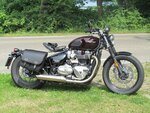
When talking about aesthetics and styling, the difference becomes a lot clearer. The two Bobbers follow two very different styles.
The Triumph is one of the very few motorcycles of its kind that hits the bobber design right on the spot. Fitted with a tubular metal body and a smaller, more compact engine, the Triumph stands out as an ultra-slim bobber. And the extra seat height certainly makes you feel like you’re surfing on clouds.
Standing in stark contrast to that, the Scout Bobber has big bulky proportions. It’s not too big, so it’s still worthy of being a lightweight bobber. But the design can put a lot of people off, especially if they’re comparing it to the Triumph Bobber.
In terms of customization, however, the Scout is a good choice by all means. Yes, the Triumph has hundreds of accessories available made by Triumph. But the Scout is a V-Twin Bobber, meaning it can borrow accessories from other brands as well.
Putting that aside, if we talk about just the aesthetics, the Triumph wins over the Scout.
Pricing:
Finally, we talk about pricing. Since the Scout Bobber vs. Triumph Bobber is a premium-quality Bobber, the price is exceptionally well-placed. The retail price is never fixed, and you have to factor in registration and licensing fee. But the Manufacturer’s Recommended Retail Price (MSRP) does justice to both the bikes.
However, the Scout has more pricing options. It’s available in many colors and even features a separate ABS-enabled model. The Triumph only gives you two options: Jet Black and Matte Black.
You also need to consider that the ABS is already included in the Triumph. For this reason, the price of the Triumph also appears to be justified. However, it doesn’t allow you to opt-out of the ABS slightly reduces your buying power.
For this reason, the Scout is better priced. Otherwise, they’re both worth the price you get them for.
Scout Bobber Vs. Triumph Bobber – The Similarities:
Fuel and Vehicle Type:
One of the biggest and quite frankly most apparent similarities between the two is that they’re both bobbers. For those of you who don’t know, Bobbers are motorcycles with extra parts and weight removed. They’re not all that different when it comes to design, either. But the Scout has a bulkier design, whereas the Triumph sticks to what a true Bobber should look like. Additionally, both these bikes run on gasoline.
Engine and Performance:
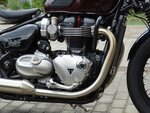
While we already discussed the differences in performance, it’s also important to discuss the similarities. The Scout and the Triumph, although they have different engines, generate the same max torque. They’re also quite similar in fuel efficiency. And since both of them are liquid-cooled, you can expect them to be quite temperature-stable. However, the Scout has a more powerful engine while the Triumph has a smaller one.
Ignition and Gearing System:
Both the Triumph and the Scout feature similar ignition and gearing systems. The ignition key in both the bikes is situated close to the motor, a classic setup from a Bobber’s perspective.
They also offer a 6-speed transmission, which is typical of most bikes today. What’s more, both the Scout and the Triumph use wet multi-plate clutch, though the Triumph also uses an assist. The gear shifting mechanism on both bikes is electronic.
Additional Features:
Aside from everything mentioned above, the bikes also feature similar tire sizes, though not the same brands. And while the brakes are everything but similar, both the bikes can be found with ABS. The seats are also placed at similar heights. But the seat on the Triumph sits slightly higher and can be adjusted in height as you please.
Scout Bobber Vs. Triumph Bobber – Pros & Cons:
Scout Bobber:
Pros:
- More powerful engine.
- Lighter kerb weight.
- Comfier seat.
- More customization options.
- Better-priced.
Cons:
- Not very aesthetic.
- No engine modes.
Triumph Bobber:
Pros:
- Includes engine modes.
- ABS-enabled.
- Slim, compact design.
- Special Showak fork.
- Longer rear travel.
Cons:
- Priced higher.
- Weaker engine.
Conclusion
In the comparison between Scout Bobber vs. Triumph Bobber, both bikes are quite similar. But a verdict is still due. After assessing the different buying factors, it concludes that the Triumph Bobber is the better choice. And the reasons are clear.
The main reason is a small size. Bobbers were made to cut down on excess weight, and the Triumph lives up to that legacy. Plus, you get the added benefit of engine modes, something you don’t see on the Scout.
Aside from that, both the Scout and the Triumph have intriguing purchases.
Featured Image from Flickr © ILIYA STEBNYOV – The original image was not changed
Featured Image from Flickr © Bedouin.DNA – The original image was not changed

